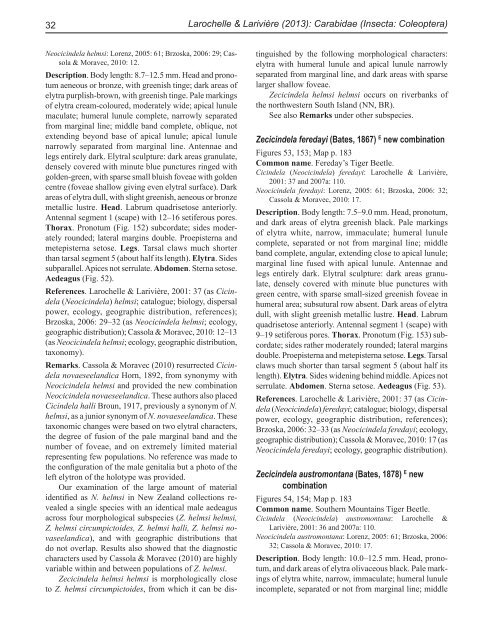Fauna of New Zealand 69 - Landcare Research
Fauna of New Zealand 69 - Landcare Research
Fauna of New Zealand 69 - Landcare Research
You also want an ePaper? Increase the reach of your titles
YUMPU automatically turns print PDFs into web optimized ePapers that Google loves.
32<br />
Neocicindela helmsi: Lorenz, 2005: 61; Brzoska, 2006: 29; Cassola<br />
& Moravec, 2010: 12.<br />
Description. Body length: 8.7–12.5 mm. Head and pronotum<br />
aeneous or bronze, with greenish tinge; dark areas <strong>of</strong><br />
elytra purplish-brown, with greenish tinge. Pale markings<br />
<strong>of</strong> elytra cream-coloured, moderately wide; apical lunule<br />
maculate; humeral lunule complete, narrowly separated<br />
from marginal line; middle band complete, oblique, not<br />
extending beyond base <strong>of</strong> apical lunule; apical lunule<br />
narrowly separated from marginal line. Antennae and<br />
legs entirely dark. Elytral sculpture: dark areas granulate,<br />
densely covered with minute blue punctures ringed with<br />
golden-green, with sparse small bluish foveae with golden<br />
centre (foveae shallow giving even elytral surface). Dark<br />
areas <strong>of</strong> elytra dull, with slight greenish, aeneous or bronze<br />
metallic lustre. Head. Labrum quadrisetose anteriorly.<br />
Antennal segment 1 (scape) with 12–16 setiferous pores.<br />
Thorax. Pronotum (Fig. 152) subcordate; sides moderately<br />
rounded; lateral margins double. Proepisterna and<br />
metepisterna setose. Legs. Tarsal claws much shorter<br />
than tarsal segment 5 (about half its length). Elytra. Sides<br />
subparallel. Apices not serrulate. Abdomen. Sterna setose.<br />
Aedeagus (Fig. 52).<br />
References. Larochelle & Larivière, 2001: 37 (as Cicindela<br />
(Neocicindela) helmsi; catalogue; biology, dispersal<br />
power, ecology, geographic distribution, references);<br />
Brzoska, 2006: 29–32 (as Neocicindela helmsi; ecology,<br />
geographic distribution); Cassola & Moravec, 2010: 12–13<br />
(as Neocicindela helmsi; ecology, geographic distribution,<br />
taxonomy).<br />
Remarks. Cassola & Moravec (2010) resurrected Cicindela<br />
novaeseelandica Horn, 1892, from synonymy with<br />
Neocicindela helmsi and provided the new combination<br />
Neocicindela novaeseelandica. These authors also placed<br />
Cicindela halli Broun, 1917, previously a synonym <strong>of</strong> N.<br />
helmsi, as a junior synonym <strong>of</strong> N. novaeseelandica. These<br />
taxonomic changes were based on two elytral characters,<br />
the degree <strong>of</strong> fusion <strong>of</strong> the pale marginal band and the<br />
number <strong>of</strong> foveae, and on extremely limited material<br />
representing few populations. No reference was made to<br />
the configuration <strong>of</strong> the male genitalia but a photo <strong>of</strong> the<br />
left elytron <strong>of</strong> the holotype was provided.<br />
Our examination <strong>of</strong> the large amount <strong>of</strong> material<br />
identified as N. helmsi in <strong>New</strong> <strong>Zealand</strong> collections revealed<br />
a single species with an identical male aedeagus<br />
across four morphological subspecies (Z. helmsi helmsi,<br />
Z. helmsi circumpictoides, Z. helmsi halli, Z. helmsi novaseelandica),<br />
and with geographic distributions that<br />
do not overlap. Results also showed that the diagnostic<br />
characters used by Cassola & Moravec (2010) are highly<br />
variable within and between populations <strong>of</strong> Z. helmsi.<br />
Zecicindela helmsi helmsi is morphologically close<br />
to Z. helmsi circumpictoides, from which it can be dis-<br />
Larochelle & Larivière (2013): Carabidae (Insecta: Coleoptera)<br />
tinguished by the following morphological characters:<br />
elytra with humeral lunule and apical lunule narrowly<br />
separated from marginal line, and dark areas with sparse<br />
larger shallow foveae.<br />
Zecicindela helmsi helmsi occurs on riverbanks <strong>of</strong><br />
the northwestern South Island (NN, BR).<br />
See also Remarks under other subspecies.<br />
Zecicindela feredayi (Bates, 1867) E new combination<br />
Figures 53, 153; Map p. 183<br />
Common name. Fereday’s Tiger Beetle.<br />
Cicindela (Neocicindela) feredayi: Larochelle & Larivière,<br />
2001: 37 and 2007a: 110.<br />
Neocicindela feredayi: Lorenz, 2005: 61; Brzoska, 2006: 32;<br />
Cassola & Moravec, 2010: 17.<br />
Description. Body length: 7.5–9.0 mm. Head, pronotum,<br />
and dark areas <strong>of</strong> elytra greenish black. Pale markings<br />
<strong>of</strong> elytra white, narrow, immaculate; humeral lunule<br />
complete, separated or not from marginal line; middle<br />
band complete, angular, extending close to apical lunule;<br />
marginal line fused with apical lunule. Antennae and<br />
legs entirely dark. Elytral sculpture: dark areas granulate,<br />
densely covered with minute blue punctures with<br />
green centre, with sparse small-sized greenish foveae in<br />
humeral area; subsutural row absent. Dark areas <strong>of</strong> elytra<br />
dull, with slight greenish metallic lustre. Head. Labrum<br />
quadrisetose anteriorly. Antennal segment 1 (scape) with<br />
9–19 setiferous pores. Thorax. Pronotum (Fig. 153) subcordate;<br />
sides rather moderately rounded; lateral margins<br />
double. Proepisterna and metepisterna setose. Legs. Tarsal<br />
claws much shorter than tarsal segment 5 (about half its<br />
length). Elytra. Sides widening behind middle. Apices not<br />
serrulate. Abdomen. Sterna setose. Aedeagus (Fig. 53).<br />
References. Larochelle & Larivière, 2001: 37 (as Cicindela<br />
(Neocicindela) feredayi; catalogue; biology, dispersal<br />
power, ecology, geographic distribution, references);<br />
Brzoska, 2006: 32–33 (as Neocicindela feredayi; ecology,<br />
geographic distribution); Cassola & Moravec, 2010: 17 (as<br />
Neocicindela feredayi; ecology, geographic distribution).<br />
Zecicindela austromontana (Bates, 1878) E new<br />
combination<br />
Figures 54, 154; Map p. 183<br />
Common name. Southern Mountains Tiger Beetle.<br />
Cicindela (Neocicindela) austromontana: Larochelle &<br />
Larivière, 2001: 36 and 2007a: 110.<br />
Neocicindela austromontana: Lorenz, 2005: 61; Brzoska, 2006:<br />
32; Cassola & Moravec, 2010: 17.<br />
Description. Body length: 10.0–12.5 mm. Head, pronotum,<br />
and dark areas <strong>of</strong> elytra olivaceous black. Pale markings<br />
<strong>of</strong> elytra white, narrow, immaculate; humeral lunule<br />
incomplete, separated or not from marginal line; middle
















